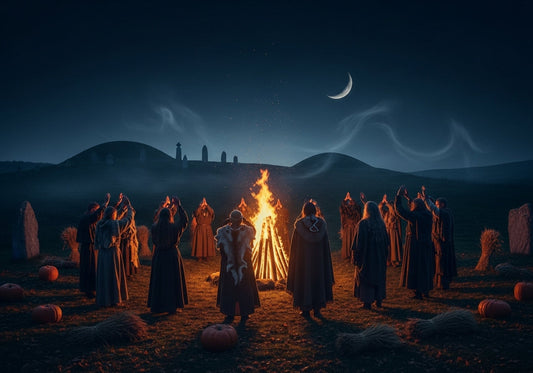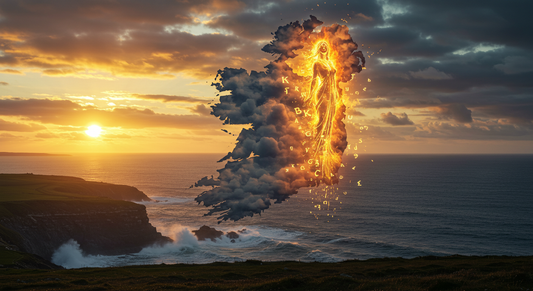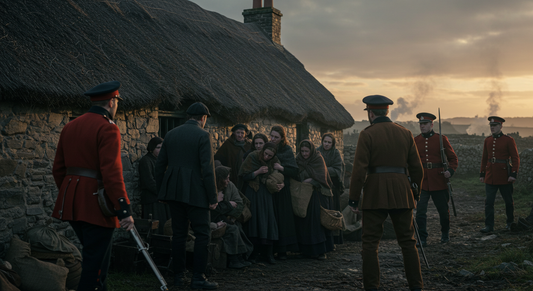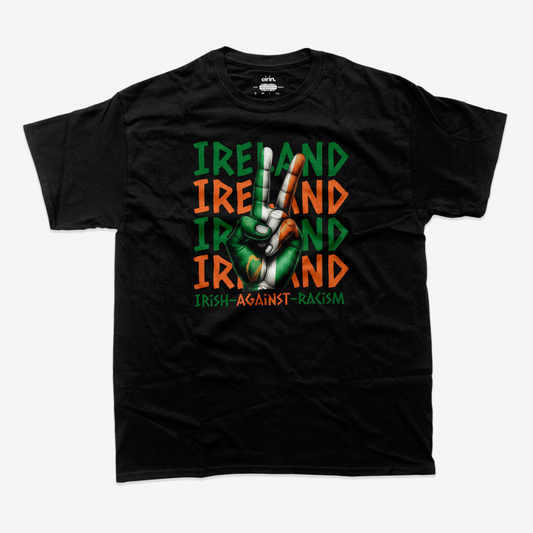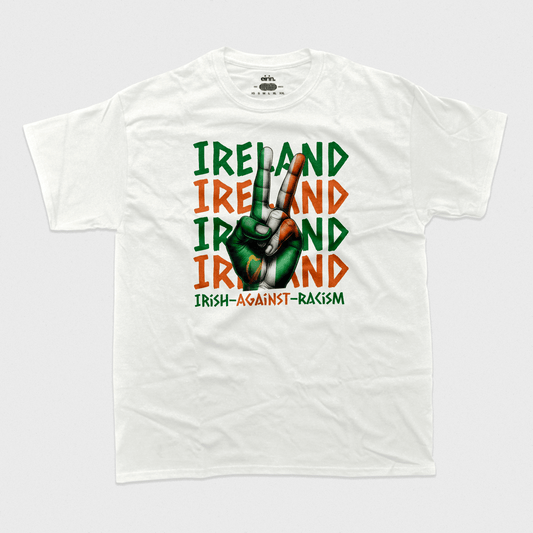We stand at the precipice of a global celebration known as Halloween. To truly understand its depth and significance, we must travel back over two millennia to ancient Ireland and the powerful Celtic fire festival known as Samhain (often spelled Samain). This pivotal event in the Gaelic calendar was not merely a celebration; it was the moment when the cosmic order was momentarily suspended, and the border between the human world and the spirit world dissolved.
Samhain is the foundational bedrock of modern Halloween, representing a complex fusion of spirituality, agrarian practices, and profound ancestral reverence. Through this exploration, we reveal how the rituals of the ancient Celts forged a spiritual legacy that defines the true Celtic roots of Halloween.

The Celtic Year's Sacred Threshold: Defining Samhain
To the ancient Celts, time was cyclical, defined by the rhythm of light and darkness. Samhain, occurring around November 1st, marked the most critical transition: the hinge upon which the old year turned into the new. It was the paramount of the four great Celtic fire festivals (quarter days), initiating the darker half of the year.
The festival’s importance stems from its timing. It was the culmination of the old year and the dawn of the pagan new year. Because the Celts believed the day began with the darkness, the festivities commenced on Oíche Shamhna (Samhain Night) or the eve of Samhain—a pattern that survives in the term Hallowe'en (All Hallows' Eve). We recognize Samhain as a time outside of time, when the customary rules of nature were temporarily suspended, granting the festival its immense magical significance.
Samhain was a practical and spiritual checkpoint for ancient Ireland. It signaled the end of the harvest and the necessary culling of livestock to prepare for winter's beginning. This culling not only secured food but also provided the bones for the communal bonfires—the "bone fires"—central to the rituals. This move from the abundance of summer into the lean, cold season necessitated both physical preservation and spiritual protection, fundamentally linking the harvest's end to the start of the new year.

The Thinning Veil: When the Spirit World Intersects Our Own
The most potent characteristic of Samhain was the belief that the veil—the barrier separating the living from the Otherworld—grew thin enough to allow free passage. This was a core theological tenet that mandated specific customs and spiritual vigilance.
The Aos Sí and the People of the Sídhe
With the veil thinned, inhabitants of the Otherworld were free to roam. These included the powerful supernatural race known as the Aos Sí (People of the Mounds) or the Sídhe. Believed to dwell in the ancient burial mounds, these beings emerged at Samhain, bringing unpredictable chaos and demanding appeasement. It was customary to leave offerings of food and drink on doorsteps or at dangerous liminal spaces like crossroads, representing an early form of ritual bargaining.
Donn, Lord of the Dead, and the Ancestral Cult
Samhain was primarily the great feast of the dead, centered on welcoming and venerating the family’s ancestors. It was believed that loved ones could return home, and food was often laid out for them.
The mythological figure most associated with the dead is Donn, widely acknowledged as the Lord of the Dead. He resided at Tech Donn (The House of Donn), a metaphorical destination for the deceased. The recognition and appeasement of Donn and the ancestors were vital.
To protect themselves from malevolent spirits, the living would don frightening costumes and masks. By masquerading as one of the roaming dead, they sought to confuse or repel genuine harmful entities, a direct precursor to the modern custom of dressing up on Hallowe'en.

Druidic Rituals and the Illuminating Power of the Bonfires
The organization and performance of the Samhain rituals fell to the Druids, the priestly class of the Celts. Their ceremonies focused on prophecy, cleansing, and the indispensable power of fire.
The spiritual heart of Samhain in ancient Ireland was the Hill of Tlachtga (Hill of Ward). It was here that the Druids annually hosted the Great Fire Festival. This ritual was intended to assist the weakening sun on its descent for the winter and was a public declaration of the community's resolve.
Tradition mandated that every household fire had to be ceremonially extinguished before Oíche Shamhna. The only permitted flame was the great, sacred fire of Tlachtga. Only then could brands be carried from the festival to relight the fires in every home. This act served as communal renewal, signifying the start of the new year with a sacred, protective flame.

Societal and Mythological Significance
The disruption of the natural order at Samhain made it the most powerful night for divination—the practice of predicting the future. We find echoes of these practices in modern Halloween traditions, particularly fortune-telling games, where rituals were performed to glimpse future spouses or the fate of community members.
These rituals blended with communal feasting and games involving special foods like barmbrack (a fruit bread containing tokens for fortune-telling). This helped bring the chaos of the supernatural world into a manageable, playful context.
In Irish mythology, Samhain is the setting for the most dramatic and magical events. It was a time of cosmic consequence: the great Cattle Raid of Cooley begins on Samhain, and heroes like the god Lugh and the warrior band of the Fianna are intrinsically linked to the festival. Even the Hill of Tara, while secondary to Tlachtga, retains its spiritual connection through the ancient alignment of the Mound of the Hostages with the Samhain sunrise.

The Inevitable Christianization: From Samhain to All Hallows' Eve
As Christianity took root, the Church employed a strategy of integration, overlaying Christian holidays onto existing pagan ones. This process of Christianization culminated in the establishment of All Saints' Day (All Hallows’ Day) on November 1st, dedicated to commemorating saints. This was followed by All Souls' Day on November 2nd, dedicated to the faithful departed.
By placing these observances directly onto and after Samhain, the Church successfully appropriated the central theme of honoring the dead. The name Hallowe'en itself is a linguistic bridge, a contraction of All Hallows' Eve. The old customs of wearing masks and costumes evolved into the practice of mummery or souling—going door-to-door for food—which is the direct ancestor of trick or treat. This ritual exchange echoes the ancient necessity of providing an offering ('treat') to avoid the malevolence ('trick') of unappeased spirits.
The Celtic roots of Halloween were further cemented globally by the Irish Diaspora. Immigrants brought their traditions to North America, where customs like carving turnips were transformed into the pumpkin-based Jack-o'-lantern, demonstrating the enduring adaptability of the Samhain fire festival.
The legacy of Samhain remains a powerful cultural force, ensuring that the modern celebration, in all its forms, remains a profound acknowledgment of the continuous link between the living and the spirit world.
